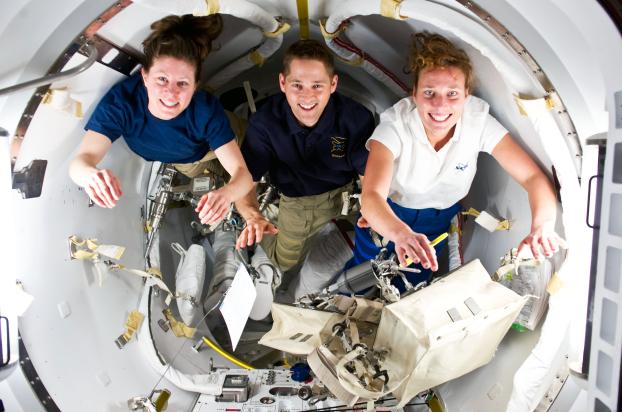 Caption: NASA astronauts, from left, Tracy Caldwell Dyson, James P. Dutton Jr., and Dorothy
Metcalf-Lindenburger, working together in tight quarters in the International Space
Station. Photo courtesy NASA
Caption: NASA astronauts, from left, Tracy Caldwell Dyson, James P. Dutton Jr., and Dorothy
Metcalf-Lindenburger, working together in tight quarters in the International Space
Station. Photo courtesy NASA
Having 'The Right Stuff'
On Long-Term Space Missions, Smooth Relationships are a Must
Cal State Fullerton alumna Tracy Caldwell Dyson (B.S. in chemistry ’93), serving aboard the International Space Station since April 4, is realizing her dream to live and work in space. Now, she may be facing her biggest challenge: Living and working where she wanted. That dream job has broken others.
In 1973, the three U.S. astronauts on Skylab, feeling mission control was too demanding, mutinied. They shut communications for 24 hours and took a break. None of those astronauts went to space again.
When Russian cosmonauts Yuri Romanenko and Alexandr Laveikin were on the Mir station in 1987, Romanenko became so antagonistic with the ground that other crewmembers took over communications. Laveikin admitted to Mary Roach, author of “Packing for Mars,” that he had thoughts of suicide.
Nick Kanas, a UC San Francisco psychiatry faculty member and leader of key NASA-funded studies of psychosocial behavior on long missions, offers this insight: “What seems to be happening on long, isolated missions is people, feeling strain or conflict, stuff their strong feelings. This is as true of Antarctic as space expeditions. They withdraw, speaking only to conduct business, and pursue hobbies to avoid the others. Their lives depend on one small group and they don’t want to antagonize them.”
The other two options, Kanas said, are taking it out on a third party, as the Skylab crew and Romanenko did, or turning it inward, as Laveikin did. All are to be avoided, he said.
Stations have been in space for nearly 40 years, and their crews have always lived in tight quarters for months while under high stress, with a heavy workload and no place for a break. Weightlessness makes bathing and cooking, even using the commode, complicated and causes detrimental changes, like bone and muscle loss that can be counteracted only by strenuous exercise. Velcro is everywhere so objects won’t float away. Private quarters are the size of a small closet. Orbiting makes the sun rise and set many times a day. Family and friends are far away, and so are the everyday smells and sights of Earth. Crewmembers have to be on guard always against leaks, bursts of solar radiation, heat buildup, even meteor strikes and debris collisions.
In addition, the ISS crewmates come from multiple cultures, languages and professional backgrounds, and both genders.
Because astronauts are highly accomplished, including in putting on their best face in front of others, we may not know how well Caldwell Dyson is doing until she returns, Kanas said.
But at least one person is sure she is coping well.
Koichi Wakata, a highly honored Japanese Aerospace Exploration Agency astronaut — the first Japanese crewmember on the Space Station — who was on three U.S. Space Shuttle flights and a Russian Soyuz flight, trained with Caldwell Dyson. He said that during a required wilderness survival exercise with a NASA astronaut group, Caldwell Dyson showed how impressive she was.
“There was a new group leader each day, and during the day, there were situational leaders, too, such as for finding a campsite and building a shelter. It was intensive leadership-followership training, along with bonding and group problem-solving. You get past differences quickly when you work in close quarters and everyone leads," Wakata said. “Tracy was remarkable. She did everything well. She continues to do well. Look what she did with the (space) walks to change the coolant pump. We (the astronaut corps) are proud of her.”
No study results are available for the 16 months since six-person crews began serving on the Space Station, but with three, there can be an “odd man out,” said Kanas, whose work focused on crews of three on Mir and ISS.
The dynamics change with four or more, the researcher said. “Everyone can find a ‘buddy’ for support” so ISS crewmembers now have it a little easier, he added.
But trumping all is personality, Kanas said.
Wakata echoed Kanas’ assessments.
Based on his experiences, he said: “Station missions are marathons and have continual maintenance, drills, experiments, space walks, Shuttle dockings and new people. Adjustment took weeks,” he said. “But I found that individual differences are biggest, so we respected those to work well together. That is important because of the situational leadership and followership. There is a station commander, but whoever is the expert leads an activity.”
Space agencies have learned from past missions that communication is key to smooth mission relationships, Kanas and Wakata agree.
Astronauts and cosmonauts must be fluent in Russian and English, the languages of space exploration. They study, work and train together for a year in multiple countries before launching, absorbing language and culture. They work in mission control. They regularly report their feelings to NASA. Communication continues during flights — crewmembers talk things over, there is constant back-and-forth with mission control and both ground and crew fill out questionnaires for medical and psychological staff.
There is subtler communication, too: Surprises come up on supply modules, like favorite snacks mentioned by crewmembers, showing the ground crew listened and cared. Lucid got M&Ms.
“We talked to the ground even when it wasn’t business," Wakata said. "We wanted to keep up the relationships.”
Because of those relationships, he said, “the Station crew believed mission control was trying to make things as safe, smooth and productive as possible.
"We felt a partnership,” Wakata said. “After the training and working and talking together, we saw ourselves as a second family.”
September 20, 2010
